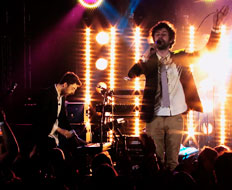Today’s young adults and teenagers—Millennials and Gen Z—are a coveted consumer demographic in quick service and are driving industry trends. Reaching these consumers, however, is an evolving process, especially since some experts believe traditional media and Facebook use are on the decline among members of those demographics.
A few quick-serve and fast-casual concepts have caught on to the trend and are trying outside-the-box marketing tactics to attract younger consumers.
Jack in the Box, for example, recently employed a newer channel, the social media app Vine, in its latest marketing campaign, “Go Big.” Hoping to engage its digitally motivated demographic, Jack in the Box rolled out 102 Vine videos in only five days.
“They're a very digital, very mobile group, and Vine fits into that really well. We also know that they are heavy users of online video,” says John Gross, strategist and account director for creative agency Struck, which worked with Jack in the Box on the project. “Knowing this is a new platform—and it does combine digital and mobile, and it does add in that online video element—we figured it would be a very good fit for our audience.”
Gross says the project has been a success, driving traffic to stores and to the brand's website.
“I think the unique aspect to this promotion is that not only are all of these Vines living within the app itself and within the Jack in the Box profile there, but we have also pulled them all into our own website as well,” he says. “We're seeing really good engagement on that promotion page where they are housed.”
Jason Wright, group strategy director for marketing and advertising provider The VIA Agency, says Millennials are constantly searching for a new, engaging, and exciting media outlet.
“I don't know that [restaurant brands] are attracting newer people into that space,” Wright says. “I think that [young people] are looking for different social channels, whether it be Instagram or some of the other ones similar to that.”
Wright says creativity is key when using social media outlets to attract the younger demographics. Facebook and Twitter have become such common promotional tools, he says, that brands wanting to set themselves apart must be able to use social channels in a unique way.
“There are so many brands using it, so many companies using it, that it's not unlike what you would consider to be traditional media,” Wright says. “It's just so saturated with different programs and platforms that people are launching through Facebook that it may just become more white noise where it is easy to ignore them.”
Other brands are integrating social media in new ways to get in front of Millennials and teenagers. Subway, for example, is launching a partnership with Lionsgate surrounding the second “Hunger Games” movie, a partnership that will include product packaging specially marked with codes that direct customers online and an invitation for customers to share photos through social channels.
Taco Bell, meanwhile, rolled out multiple campaigns that weave social media together with culture and creativity. To launch its Fiery Doritos Locos Taco flavor, the brand employed dozens of high-profile YouTube users to create quirky ads, like one that joked about a Doritos Locos Taco 3D printer. Taco Bell also enhanced its indie-band-supporting “Feed the Beat” program with the documentary “Hello Everywhere,” which follows bands Passion Pit and Wildcat! Wildcat! as they prepare for the South by Southwest festival. The “rockumentary” can be streamed online.
Chris Brandt, chief marketing officer for Taco Bell, says in an e-mail that social media traffic and active participation does not happen overnight. Taco Bell's “Feed the Beat” promotion began in 2006 as an effort to help feed up-and-coming artists on tour with Taco Bell gift cards. Over the years, “Feed the Beat” has built Millennial engagement both online and in stores.
“In listening to our fans, we know that our core demographic loves music of all genres, and they want to be the first to discover and share new music,” Brandt says. “The ‘Feed The Beat’ program connects fans with bands and bands with fans through exclusive content, behind-the-scenes footage, and social engagement.”
Taco Bell has more than 10 million Facebook fans, 700,000 Twitter followers, and 163,000 Instagram followers, due in part to the “Feed the Beat” campaign. Brandt says a brand's social media success hinges on its ability to provide attractive content and to consistently interact with the social community.
“Providing fans with this kind of access is part of Taco Bell’s overall strategy in becoming a better and more relevant brand for our consumers,” Brandt says.
Wright says Taco Bell is a great example of brands cleverly linking social media to marketing campaigns, and he encourages other foodservice companies to pursue a similar approach.
“You can't look at social media platforms as the primary or the only way to engage [young consumers],” he says. “It is certainly one way, but there are a multitude of other opportunities out there to reach those consumers, and to think social media is the only way of doing that is foolish.”










